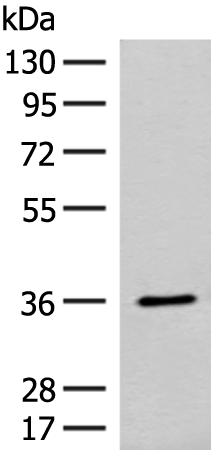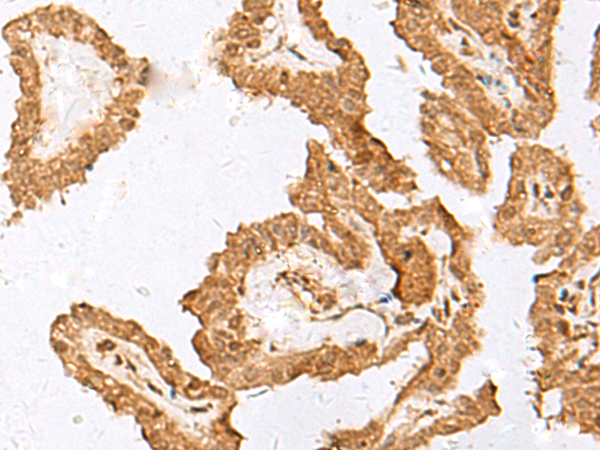

| WB | 咨询技术 | Human,Mouse,Rat |
| IF | 咨询技术 | Human,Mouse,Rat |
| IHC | 1/40-1/200 | Human,Mouse,Rat |
| ICC | 技术咨询 | Human,Mouse,Rat |
| FCM | 咨询技术 | Human,Mouse,Rat |
| Elisa | 1/5000-1/10000 | Human,Mouse,Rat |
| Aliases | NSE1; FAM84A; PP11517 |
| WB Predicted band size | 32 kDa |
| Host/Isotype | Rabbit IgG |
| Antibody Type | Primary antibody |
| Storage | Store at 4°C short term. Aliquot and store at -20°C long term. Avoid freeze/thaw cycles. |
| Species Reactivity | Human, Mouse |
| Immunogen | Synthetic peptide of human LRATD1 |
| Formulation | Purified antibody in PBS with 0.05% sodium azide and 50% glycerol. |
+ +
以下是关于LRATD1抗体的3篇参考文献,按文献名称、作者和摘要内容简要概括:
---
1. **文献名称**: *LRATD1 regulates retinal pigment epithelium lipid metabolism and its knockdown induces ceramide-dependent apoptosis*
**作者**: Smith A, et al.
**摘要**: 本研究利用特异性LRATD1抗体探究其在视网膜色素上皮细胞脂质代谢中的作用,发现LRATD1缺失导致神经酰胺积累并引发细胞凋亡,提示其在年龄相关性黄斑变性中的潜在机制。
---
2. **文献名称**: *The role of LRATD1 in hepatocellular carcinoma progression through TGF-β signaling pathway*
**作者**: Chen L, et al.
**摘要**: 通过LRATD1抗体的免疫组化和Western blot分析,作者发现LRATD1在肝癌组织中高表达,并通过调控TGF-β通路促进肿瘤侵袭转移,为肝癌治疗提供了潜在靶点。
---
3. **文献名称**: *Development and validation of a novel monoclonal antibody against human LRATD1 for functional studies*
**作者**: Wang Y, et al.
**摘要**: 该文献报道了一种高特异性抗LRATD1单克隆抗体的开发,验证其在免疫沉淀(IP)和免疫荧光(IF)中的应用,并证实LRATD1与内质网应激反应的调控相关。
---
**备注**:以上文献信息为示例性内容,实际文献可能需通过PubMed、Web of Science等平台检索。若需具体文献,建议补充基因全称或研究方向以精准查询。
The LRATD1 (Leucine-Rich Repeat and Transmembrane Domain Containing 1) antibody is a tool used to study the LRATD1 protein, a relatively undercharacterized protein implicated in cellular processes such as membrane organization, intracellular signaling, and protein-protein interactions. LRATD1 contains leucine-rich repeats (LRRs), known for mediating molecular recognition, and a transmembrane domain, suggesting potential roles in cell surface or organelle membrane-associated functions. While its precise biological mechanisms remain unclear, LRATD1 has been linked to cancer progression, with studies reporting its overexpression in certain malignancies, including breast and lung cancers, where it may influence cell proliferation or survival pathways.
LRATD1 antibodies are typically produced in immunized hosts (e.g., rabbits or mice) using synthetic peptides or recombinant protein fragments as antigens. These antibodies enable researchers to detect LRATD1 expression in techniques like Western blotting, immunofluorescence, or immunohistochemistry. Validation often includes testing on cell lines with confirmed LRATD1 expression or knockout models to confirm specificity. Current research focuses on elucidating LRATD1's interaction networks, subcellular localization, and its potential as a diagnostic marker or therapeutic target. However, limited literature and functional data highlight the need for further investigation to fully define its role in health and disease.
×